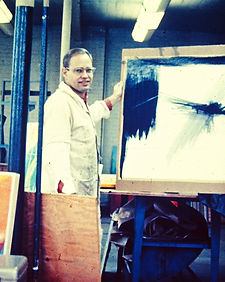HERB ROGALLA
ART
Herb grew up in Denver, Colorado where the nearby mountains brought a deep appreciation of the vast visual power of nature. His father was a grower in floral greenhouses, and Herb's early experiences there inspired a more intimate sense of the power of both color and form.
As a teenager, Herb trained in sign painting. World War ll then took him to the Pacific as a medical corpsman in the Navy. Early drawings of Herb's family and those from his World War ll sketchbook reveal his interest in developing his own artistic expression.
After the war Herb traveled to Amarillo, Texas, where he learned commercial art skills while working at an advertising agency. In 1947 he moved to Dallas, pursuing further artistic training at Southern Methodist University and at the Dallas Museum of Art.
Herb's art studies there strengthened his relationships within the Texas art community. Jerry Bywaters, Otis Dozier, and Octavio Medellin were among his early teachers who also became close friends.
1945, Clancey on ship

1946, Herb's Father
1950, Black Hawk, Colorado
Herb met his wife, Jett, in a painting class at the Dallas museum. They married in 1949, and made an adventurous move to New York City in 1952. There Herb attended Columbia University and the art school of Hans Hofmann. Classes filled the days, and Herb worked commercial art jobs in the evenings. This proved to be an exciting time, feeding a need for new experiences, new friends, and serious study.
When family matters brought a return to Dallas, Herb and Jett became involved in the formative work that helped to launch the first Dallas Museum for Contemporary Art. Friendships grew with fellow artists, Roger Winter, David McManaway, Bill Komodore, and Haynes Ownby among others. Through the years Herb participated in group exhibitions, one man shows, and regional competitions. On the gallery and museum side, Paul Harris, Murray Smither, and Douglas MacAgy provided strong support. In the media, Janet Kutner published many insightful reviews of Herb's work, increasing awareness of it throughout Texas.
In the midst of a productive fine art career Herb also started a career in teaching. In 1966 St. Mark's School of Texas, a well known boys' prep school, asked him to teach upper school art. He took the challenge, and balanced a teaching schedule with continuing creation of his own work. His ability to inspire his students quickly became apparent, and he taught for the next twenty eight years.
Around the time he started teaching Herb moved into a more exploratory phase with his work. He was intrigued by experimentation utilizing materials emerging at the time: plastics, poly-resin, PVC pipe, Plexiglas, aluminum, and liquids. He also continued serious work in painting and drawing, consistently revealing his dedication to the powers of color. His approach was both cerebral and sensory, with some works based in emotion and some concerned mainly with visual effect.
Moving forward, Herb seemed compelled to bring his vision to a larger audience. His work grew larger than the studio. Commissions and grants brought large scale sculpture projects for public spaces throughout the state. He created work most notably in Waco, Amarillo, Austin, San Antonio, and Dallas.

1955, Untitled

c. 1955, Jett and Herb back in Dallas

c. 1960, Herb in his Dallas studio

1964, Untitled

c. 1970, Free Floats

1973, Herb reviewing student work


1983, Lasting Red, Flower Series
"I believe that public art, if site and object/installations are in real harmony, can indeed transform a space or area as nothing else can - by linking art and architecture, art and nature, and especially
art and people."
1984, Amarillo Chroma Fugue

Herb, c. 1994
" I have always sought the ideal in my work - hoping to express order,
a sense of joy and spirit while maintaining an imaginative base."


